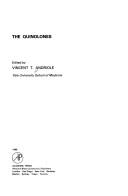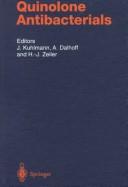| Listing 1 - 4 of 4 |
Sort by
|
Book
ISBN: 161470368X 9781614703686 9781608767366 1608767361 Year: 2010 Publisher: New York : Nova Science Publishers,
Abstract | Keywords | Export | Availability | Bookmark
 Loading...
Loading...Choose an application
- Reference Manager
- EndNote
- RefWorks (Direct export to RefWorks)
Quinolone antibacterial agents. --- Staphylococcus aureus infections --- Staphylococcal infections --- Ketoquinolines --- Oxoquinolines --- Quinolinones --- Quinolone antimicrobial agents --- Quinolones --- Antibacterial agents --- Synthetic drugs --- Chemotherapy.

ISBN: 012059515X Year: 1988 Publisher: London Academic press
Abstract | Keywords | Export | Availability | Bookmark
 Loading...
Loading...Choose an application
- Reference Manager
- EndNote
- RefWorks (Direct export to RefWorks)
Quinolines. --- #Lilly --- Quinolone antibacterial agents. --- Quinolinones. --- Quinolone antibacterial agents --- Quinolines --- Ketoquinolines --- Oxoquinolines --- Quinolinones --- Quinolone antimicrobial agents --- Quinolones --- Antibacterial agents --- Synthetic drugs
Book
ISBN: 0120595176 9786611024895 1281024899 0080525784 9780120595174 9781429495356 1429495359 Year: 2000 Publisher: New York, NY ; London : Academic Press,
Abstract | Keywords | Export | Availability | Bookmark
 Loading...
Loading...Choose an application
- Reference Manager
- EndNote
- RefWorks (Direct export to RefWorks)
Quinolones constitute a large class of synthetic antimicrobial agents that are highly effective in the treatment of many types of infectious diseases, particularly those caused by bacteria. New quinolones are continually being developed as bacterial species develop resistance to existing quinolones. This book presents the most current information available in our continual struggle to conquer disease.Over time, bacteria become resistant to medicines that are used to combat them. Because of this, the medical world is always in search of new and improved ways to battle these disease-causing
Quinolone antibacterial agents. --- Quinolones --- Pharmaceutical chemistry. --- Ketoquinolines --- Oxoquinolines --- Quinolinones --- Quinolone antimicrobial agents --- Antibacterial agents --- Synthetic drugs --- Chemistry, Medical and pharmaceutical --- Chemistry, Pharmaceutical --- Drug chemistry --- Drugs --- Medical chemistry --- Medicinal chemistry --- Pharmacochemistry --- Chemistry --- Anti-Infective Agents. --- Quinolones. --- Anti-infectieux.

ISBN: 3540625127 3642803660 3642803644 Year: 1997 Volume: 127 Publisher: Berlin ; Heidelberg ; New York Springer Verlag
Abstract | Keywords | Export | Availability | Bookmark
 Loading...
Loading...Choose an application
- Reference Manager
- EndNote
- RefWorks (Direct export to RefWorks)
It has been over 30 years since the first clinically important member of the quinolone class, nalidixic acid, was introduced into medical practice. The modification produced in the quinolone nucleus by introducing a fluorine at the 6-position led to the discovery of the newer fluoroquinolones with enhanced antibacterial activities as compared to nalidixic acid. By now a great deal of preclinical and clinical experience has been obtained with these agents. The intense interest in this class of antibacterial agents by chemists, micro biologists, toxicologists, pharmacologists, clinical pharmacologists, and clini cians in various disciplines encouraged us to summarize the information on the history, chemistry, mode of action and in vitro properties, kinetics and efficacy in animals, mechanisms of resistance, toxicity, clinical pharmacology, clinical experience, and future prospects in one volume of the Handbook of Experimental Pharmacology. As this series deals predominantly with "experimental" characteristics of drugs, our volume is dedicated specifically to quinolones and emphasizes principally their preclinical and clinical phar macological characteristics, despite the existence of several summaries on quinolones. The chemistry of the quinolones is described in detail. The chapter on the mode of action of quinolones reports the conclusive evidence that gyrase is the intracellular target of the quinolones; however, another enzyme, topoisomerase IV, may also be a target for quinolones, and the exact mechanisms by which quinolones act bactericidally are far from being understood.
Quinolone antibacterial agents --- Quinolone antimicrobial agents --- Quinolonen als antibacteriële agentia --- Quinolones comme antibactériens --- Anti-Infective Agents, Quinolone --- Quinolone antibacterial agents. --- Quinolones --- Therapeutic use. --- Pharmacology. --- Biochemistry. --- Microbiology. --- Internal medicine. --- Pharmacology/Toxicology. --- Biochemistry, general. --- Internal Medicine. --- Medicine, Internal --- Medicine --- Microbial biology --- Biology --- Microorganisms --- Biological chemistry --- Chemical composition of organisms --- Organisms --- Physiological chemistry --- Chemistry --- Medical sciences --- Drug effects --- Medical pharmacology --- Chemicals --- Chemotherapy --- Drugs --- Pharmacy --- Composition --- Physiological effect --- Ketoquinolines --- Oxoquinolines --- Quinolinones --- Antibacterial agents --- Synthetic drugs
| Listing 1 - 4 of 4 |
Sort by
|

 Search
Search Feedback
Feedback About
About Help
Help News
News